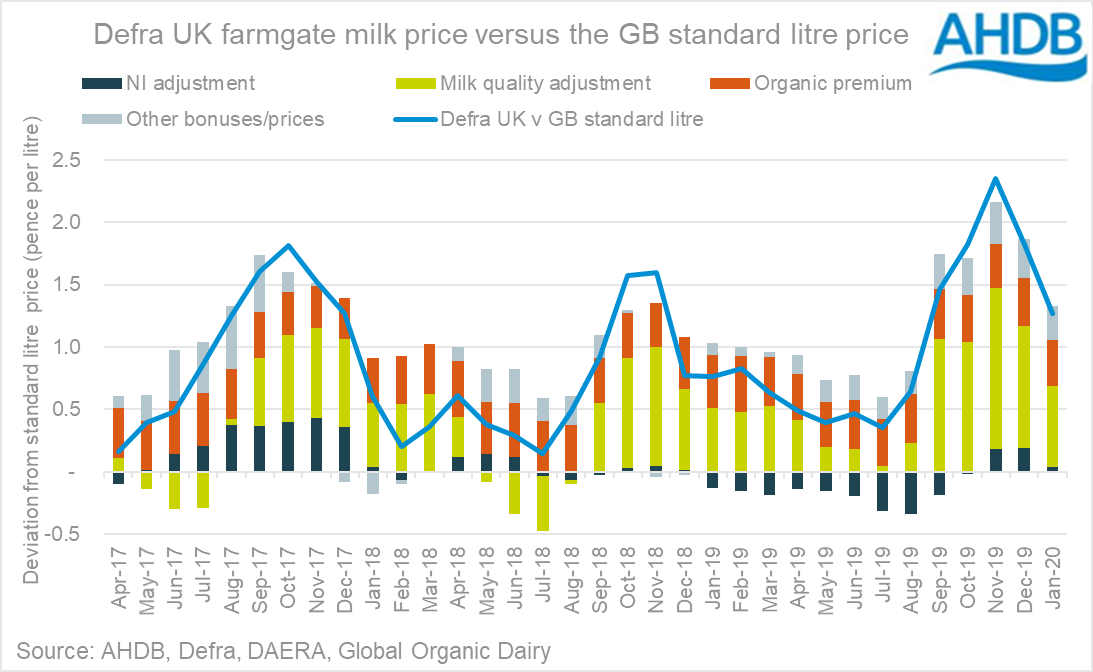Is standard litre a good estimate of milk prices?
Tuesday, 3 March 2020
By Chris Gooderham
The comparison of standard litre prices with actual payments to farmers has been a hot topic over recent months. While the two price series tend to move generally in the same direction, there are some noticeable differences that can cause the prices to diverge.
General principles
The average UK milk price quoted by Defra is calculated from the total payments made to farmers in a month divided by the volume of milk purchased. It will therefore include all payment elements that impact the price actually paid for the milk, such as:
- Compositional quality of the milk
- Hygienic quality and any bonuses or deductions
- Any seasonality adjustments
- Volume or scheme bonuses
- Any adjustments for antibiotic or downgraded milk
The standard litre price, quoted by most milk buyers and used in league tables, makes some key assumptions on the payment elements based on what they deem to be ‘normal’. While our Milk Price Calculator (MPC) allows users to enter their own specific numbers for a number of these elements, we also quote a standard litre price. Let’s look at our own standard litre and compare that with reality.

The chart above shows the difference between the UK average price, as published by Defra, and the GB standard litre price, based on our league table. We also show a breakdown of the pricing elements which create the difference, based on the areas covered below:
Northern Ireland
The first difference to note is that the Defra price is for the UK, whereas the majority of prices we quote in our league table are for GB, and do not adequately represent prices in Northern Ireland (NI). Since April 2017 there have been occasions where the NI price has been nearly 3ppl above the GB standard litre, or more than 2ppl below it. As a result, the NI price can either boost the UK average price or reduce it.
Compositional quality
Our standard litre assumes 4.07% butterfat and 3.30% protein each month. In September and October we explained the impact high compositional quality was having on farm payments. While some months show exceptional variations, in reality adjustments could be made almost every month because milk quality is rarely exactly 4.07% and 3.30%.
We estimate that, on average, manufacturing contracts pay an extra 10.4% for every 1% increase in butterfat, and 13.3% for every 1% increase in protein. Liquid contracts don’t pay so much for additional milk solids, but would still average an extra 5.1% for another 1% of butterfat.
We have seen in recent months that milk destined for manufacturing has had higher solids than the average. Therefore a boost in compositional quality can cause a significantly difference between the standard litre price and the actual price paid. Since April 2019, the high quality has boosted the average milk price by more than 0.6ppl, compared with our standard litre.
Prices omitted
Our standard litre price covers 75% of the milk collected in GB, but we cannot necessarily assume it also represents the price for the remaining 25%. For example, around 480m litres of milk in the UK is organic, which we estimate has received a premium of around 12.5ppl compared with our standard litre price since April 2017. That means our standard litre is under-reporting the average price paid in the country by around 0.39ppl.
Some of the other milk prices not included in our standard litre price have trackers linked to market prices. These prices therefore react to movements in butter, skimmed milk powder and/or cheese prices more quickly than the more normal three-month delay. We can estimate the impact of those prices on the overall average by tracking our own AMPE and MCVE. In general the inclusion of these prices make the overall price paid more volatile than the standard litre.
Other bonuses/deductions
While the MPC makes some reasonable assumptions for the standard litre, some bonus payments are not included in the quoted milk price, but instead are explained in the footnotes. Equally, there will be farmers who do not reach the top bands of hygiene, do not have every other day collections, or incur charges for some other reason. All of these potential adjustments can mean the actual price paid to farmers is different to the standard litre price quoted.
Conclusion
The Defra UK average milk price has exceeded our standard litre average price every month since April 2017. The exclusion of organic prices from the standard litre average is one of the main reasons. Higher butterfat and protein levels compared with the standard litre assumptions have also added significantly to the difference in the two prices. This was particularly evident through autumn 2019 when compositional quality hit record high levels.
We undertake a review of the assumptions in the standard litre annually, once March data is available. This year’s review should help to re-address some of the balance.

Sign up to receive the latest information from AHDB.
While AHDB seeks to ensure that the information contained on this webpage is accurate at the time of publication, no warranty is given in respect of the information and data provided. You are responsible for how you use the information. To the maximum extent permitted by law, AHDB accepts no liability for loss, damage or injury howsoever caused or suffered (including that caused by negligence) directly or indirectly in relation to the information or data provided in this publication.
All intellectual property rights in the information and data on this webpage belong to or are licensed by AHDB. You are authorised to use such information for your internal business purposes only and you must not provide this information to any other third parties, including further publication of the information, or for commercial gain in any way whatsoever without the prior written permission of AHDB for each third party disclosure, publication or commercial arrangement. For more information, please see our Terms of Use and Privacy Notice or contact the Director of Corporate Affairs at info@ahdb.org.uk © Agriculture and Horticulture Development Board. All rights reserved.

